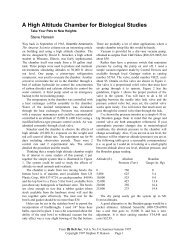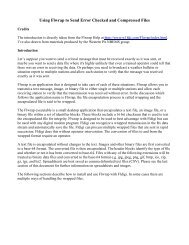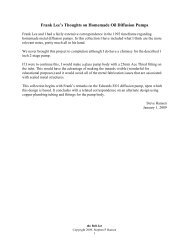Adding feedthroughs to glassware - the Bell Jar
Adding feedthroughs to glassware - the Bell Jar
Adding feedthroughs to glassware - the Bell Jar
You also want an ePaper? Increase the reach of your titles
YUMPU automatically turns print PDFs into web optimized ePapers that Google loves.
A Primer on Using Ace Threds ®<br />
<strong>Adding</strong> <strong>feedthroughs</strong> <strong>to</strong> <strong>glassware</strong><br />
Steve Hansen<br />
I. INTRODUCTION<br />
I have frequently mentioned Ace Glass Corporation’s<br />
[http://www.aceglass.com] line of proprietary Ace<br />
Thred ® connec<strong>to</strong>rs. Ace patented <strong>the</strong> configuration in<br />
1972 [1] as a gas tight, low stress connec<strong>to</strong>r. Ace makes<br />
<strong>the</strong> claim that this is “<strong>the</strong> most important glass<br />
connection since <strong>the</strong> spherical joint.” That may or may<br />
not be so, but I have found <strong>the</strong>se connec<strong>to</strong>rs <strong>to</strong> be<br />
wonderful for vacuum chambers that are designed for<br />
service in <strong>the</strong> ranges down <strong>to</strong> high vacuum.<br />
The principle of <strong>the</strong> Ace Thred is shown in Figure 1<br />
below. The thred itself is a precision molded connec<strong>to</strong>r<br />
of borosilicate glass. The glassblower attaches this<br />
connec<strong>to</strong>r <strong>to</strong> <strong>the</strong> apparatus at <strong>the</strong> desired locations. The<br />
o<strong>the</strong>r parts of <strong>the</strong> thred consist of a nylon bushing and a<br />
fluorocarbon o-ring. When assembled around an<br />
appropriately sized rod (usually aluminum if <strong>the</strong> rod is<br />
serving as an electrical feedthrough), <strong>the</strong> tightening of<br />
<strong>the</strong> bushing compresses <strong>the</strong> o-ring between <strong>the</strong> glass<br />
connec<strong>to</strong>r and <strong>the</strong> rod. The bushing is not exposed <strong>to</strong><br />
vacuum thus making <strong>the</strong> seal compatible with medium<br />
and high vacuum systems.<br />
II. SPECIFICATIONS<br />
The table below shows Ace Glass’ published data for<br />
<strong>the</strong> various sizes of Ace Thred bushings. My favorite<br />
sizes are numbers 7, 11 and 25. These take rods or tubes<br />
in diameters of 1/4, 3/8 and 1 inch respectively.<br />
In my experience <strong>the</strong> vacuum ratings are on <strong>the</strong><br />
conservative side. I have used sizes <strong>to</strong> #25 in<br />
applications well below 10 -4 Torr.<br />
Thred Size Rod OD (mm) Vacuum (Torr)<br />
#7<br />
6-7<br />
(discussed later) are different in that <strong>the</strong> nose of <strong>the</strong> plug<br />
is exposed <strong>to</strong> vacuum.<br />
III. SAFETY<br />
In <strong>the</strong> case of straight rod sections that are inserted in<strong>to</strong><br />
Ace Threds it is essential that some kind of s<strong>to</strong>p be<br />
added so that <strong>the</strong>re is no chance of <strong>the</strong> rod being drawn<br />
though <strong>the</strong> fitting by <strong>the</strong> differential pressure created by<br />
<strong>the</strong> vacuum in <strong>the</strong> apparatus. This can be done by<br />
machining a step in<strong>to</strong> <strong>the</strong> rod or, as shown in Figure 1,<br />
affixing a shaft collar or o<strong>the</strong>r device. Shaft collars are<br />
convenient since <strong>the</strong>y can be easily repositioned.<br />
I have seen a 3/8” rod get propelled axially through<br />
a piece of <strong>glassware</strong> when <strong>the</strong> Ace Thred bushing was<br />
loosened just a little bit. The result, fortunately was<br />
minor damage but <strong>the</strong> velocity of <strong>the</strong> rod was high<br />
enough <strong>to</strong> puncture <strong>the</strong> screened center rings at <strong>the</strong><br />
pump out port. Needless <strong>to</strong> say, if <strong>the</strong> rod were aimed at<br />
an adjacent glass wall, it would shatter <strong>the</strong> apparatus.<br />
As a final note, as with all glass vacuum (or<br />
pressure) apparatus, use protective eyewear at all times.<br />
IV. AN EXAMPLE<br />
When I was a teenager I constructed (well, partially<br />
constructed - I ran in<strong>to</strong> problems with <strong>the</strong> van de Graaff<br />
genera<strong>to</strong>r) a simple potential drop particle accelera<strong>to</strong>r<br />
following Frank Lee’s design that was described in a<br />
1959 Scientific American Amateur Scientist column [2]. A<br />
later column [3] described a design for a similar<br />
apparatus by Larry Cress. Figure 2 shows a rendering<br />
of <strong>the</strong> upper part of Cress’ accelera<strong>to</strong>r tube.<br />
Cress’ tube consisted of several pieces of 1-1/4 inch<br />
diameter pyrex tubes, each about 3 inches in length. The<br />
simple ion source, driven by a spark coil, was mounted<br />
on a disk of lucite. The acceleration electrodes were<br />
disks of brass with ¾ inch copper tubes soldered <strong>to</strong><br />
holes in <strong>the</strong> disks. All of <strong>the</strong> components were joined<br />
with vacuum sealing wax (Apiezon W).<br />
My take on an implementation with Ace Threds is<br />
shown in <strong>the</strong> right hand side of Figure 2. Please note<br />
that I have never built this specific tube but I have done<br />
equivalent structures many times.<br />
The ion source is at <strong>the</strong> <strong>to</strong>p of a tube that<br />
incorporates a ring seal and is <strong>to</strong>pped with an 11mm<br />
Ace Thred. A sleeve with a threaded hole in <strong>the</strong> side<br />
slips over <strong>the</strong> inner 5/8” outside diameter tube. A 7mm<br />
Ace Thred is <strong>to</strong> <strong>the</strong> side and <strong>the</strong> 1/4” diameter rod has a<br />
threaded piece that screws in<strong>to</strong> <strong>the</strong> sleeve.<br />
The acceleration electrodes are rings that are fitted<br />
<strong>to</strong> <strong>the</strong> glass tubing. Within <strong>the</strong> rings (or machined as<br />
part of <strong>the</strong> rings) are tubes, much like <strong>the</strong> copper tubes<br />
in Cress’ design. As with <strong>the</strong> ion source electrode<br />
sleeve, a 7mm Ace Thred is associated with each<br />
electrode.<br />
The target is held in a side arm that is terminated in<br />
a 25mm Ace Thred. This permits easy insertion of <strong>the</strong><br />
targets.<br />
Finally, <strong>the</strong> bot<strong>to</strong>m of <strong>the</strong> tube is a straight section<br />
that mates with a compression adapter.<br />
V. A MULTI-PURPOSE DISCHARGE TUBE<br />
A “real” design is shown in Figure 3. This tube may be<br />
used as an x-ray source, electron accelera<strong>to</strong>r or simple<br />
ion accelera<strong>to</strong>r. A Langmuir probe may also be inserted<br />
in<strong>to</strong> <strong>the</strong> tube.<br />
At <strong>the</strong> <strong>to</strong>p of <strong>the</strong> tube is a #11 Ace Thred. The <strong>to</strong>p<br />
section of glass is sized at 1 inch inside diameter so that<br />
1 inch rod and tube s<strong>to</strong>ck can be used for electrodes. A<br />
#7 feedthrough is provided just below this section. This<br />
may be used for a number of purposes such as for a bias<br />
or extraction electrode. This is also where a Langmuir<br />
probe would be inserted.<br />
The bot<strong>to</strong>m side feedthrough is a #25 Ace Thred.<br />
This can be used for targets, <strong>to</strong> hold a phosphor screen,<br />
Gas Inlet & HV<br />
Ion Source<br />
Accel Electrode<br />
(one of several)<br />
Target Holder<br />
Connection <strong>to</strong><br />
Vacuum System<br />
Figure 2 - Accelera<strong>to</strong>r Columns<br />
<strong>the</strong> <strong>Bell</strong> <strong>Jar</strong>, Vol. 11, 2008<br />
2
or as a sample holder if items are inserted for ion or<br />
electron irradiation.<br />
At <strong>the</strong> lower end is a straight section of 1-3/8 inch<br />
diameter, sized <strong>to</strong> fit a standard compression fitting.<br />
Figure 3 shows <strong>the</strong> tube in a simple cold cathode<br />
x-ray tube configuration. The cathode is an aluminum<br />
“dish” 1 inch in diameter. The target holder is made<br />
from 1 inch rod s<strong>to</strong>ck with one end milled half way<br />
through. Two 8-32 holes are drilled and tapped in <strong>the</strong><br />
flat section, about 1 inch apart. The target is made from<br />
sheet tungsten (salvaged from an evaporation boat) that<br />
is fastened by clamping <strong>the</strong> sheet under <strong>the</strong> heads of <strong>the</strong><br />
two screws. Figure 4 is a pho<strong>to</strong> of <strong>the</strong> same tube in <strong>the</strong><br />
cold cathode x-ray configuration.<br />
#11<br />
Figure 4 - Tube Configured for X-Ray Production<br />
Cathode<br />
Target Holder<br />
(at 45 deg angle)<br />
Tungsten Anode<br />
#7<br />
#25<br />
Plugs can be used <strong>to</strong> make electrical <strong>feedthroughs</strong><br />
and are especially valuable when several connections<br />
are <strong>to</strong> be made and where <strong>the</strong> plug might serve as <strong>the</strong><br />
support for a subassembly that will be in <strong>the</strong> vacuum<br />
chamber.<br />
Materials selection is important in <strong>the</strong> case of plugs<br />
as <strong>the</strong> plug material is exposed <strong>to</strong> vacuum. I’ve used<br />
nylon plugs in <strong>the</strong> #36 size down <strong>to</strong> 1 micron and teflon<br />
#50 well below that.<br />
O-ring<br />
Figure 3 - Multi-Purpose Discharge Tube<br />
VI. PLUGS & ELECTRICAL FEEDTHROUGHS<br />
Ano<strong>the</strong>r useful piece of Ace Thred hardware is <strong>the</strong> face<br />
seal plug. As shown in Figure 5 <strong>the</strong>se are simply solid<br />
bushings that have an o-ring groove near <strong>the</strong> tip. (There<br />
are also plugs that seal just under <strong>the</strong> head of <strong>the</strong> plug<br />
but <strong>the</strong>se expose <strong>the</strong> entire length of thread <strong>to</strong> vacuum<br />
and, in my experience, are not as reliable under<br />
vacuum.)<br />
Figure 5 - Ace Thred Face Seal Plug<br />
My method for making a feedthrough is shown in<br />
Figure 6. This is a 2 electrode feedthrough that I made<br />
for a miniature evaporation chamber that’s being used at<br />
a technical college. In this case I used a 36mm plug<br />
made of nylon.<br />
I used 5/16 inch diameter aluminum rod with 8-32<br />
hardware. I drilled <strong>the</strong> plug part way through <strong>the</strong> same<br />
diameter as <strong>the</strong> rod and <strong>the</strong>n continued each hole <strong>to</strong><br />
clear a length of 8-32 brass threaded rod. The seal is<br />
made by placing a small o-ring on <strong>the</strong> threaded rod<br />
<strong>the</strong> <strong>Bell</strong> <strong>Jar</strong>, Vol. 11, 2008<br />
3
5/16" Aluminum Rod<br />
O-ring<br />
#36 Front Seal<br />
Plug<br />
8-32 Brass<br />
Hardware<br />
Figure 6 - Feedthrough<br />
where it will be compressed at <strong>the</strong> bot<strong>to</strong>m of <strong>the</strong><br />
aluminum rod when <strong>the</strong> hardware is tightened. A<br />
suitable o-ring for this application would be 5/32” inside<br />
diameter x 9/32” outside diameter (1/16” cross section).<br />
Needless <strong>to</strong> say, <strong>the</strong> bot<strong>to</strong>m of <strong>the</strong> aluminum should be<br />
machined <strong>to</strong> a smooth finish.<br />
The smallest rod that I have used is 1/4” diameter<br />
with #6-32 hardware. A suitable o-ring would be 1/8”<br />
inside diameter x 1/4” outside diameter (1/16 cross<br />
section).<br />
Figure 7 shows an RF feedthrough built for a small<br />
RF sputtering chamber. The connec<strong>to</strong>r is an HN<br />
bulkhead mount type . The wire that is shown is <strong>the</strong><br />
ground connection that goes from <strong>the</strong> connec<strong>to</strong>r housing<br />
<strong>to</strong> <strong>the</strong> substrate holder.<br />
CITED REFERENCES<br />
[1] Charles M. DeWoody, Flexible Pressure-Type Joint<br />
for Rigid Tubing, US Patent 3.695,642, Oc<strong>to</strong>ber 3, 1972.<br />
[2] C. L. S<strong>to</strong>ng, How <strong>to</strong> Make an Electrostatic Machine<br />
<strong>to</strong> Accelerate Both Electrons and Pro<strong>to</strong>ns, Scientific<br />
American, June, 1959.<br />
[3] C.L. S<strong>to</strong>ng, How <strong>to</strong> Build a Machine <strong>to</strong> Produce<br />
Low Energy Pro<strong>to</strong>ns and Deuterons, Scientific<br />
American, August, 1971.<br />
Figure 7- RF Feedthrough<br />
<strong>the</strong> <strong>Bell</strong> <strong>Jar</strong>, Vol. 11, 2008<br />
4










